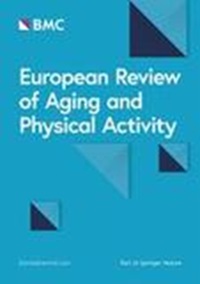Physical activity and the risk of developing 8 age-related diseases: epidemiological and Mendelian randomization studies
IF 3.5
1区 医学
Q2 GERIATRICS & GERONTOLOGY
引用次数: 0
Abstract
We aimed to characterize the associations between physical activity levels and the risk of developing age-related diseases in the Coronary Artery Risk Development in Young Adults (CARDIA) study and used Mendelian randomization (MR) to assess whether there are causal relationships between physical activity levels and the risk of developing 8 age-related diseases (coronary atherosclerosis, ischemic heart disease, angina, Alzheimer’s disease, hypertension, type 2 diabetes, hyperlipidemia, and venous thromboembolism). Based on the data available in the CARDIA, we obtained data related to five disease states: coronary heart disease, hypertension, diabetes, hyperlipidemia, and venous thromboembolism. Binary logistic regression analysis estimated the multivariable-adjusted associations between different physical activity statuses and diseases. For the MR study, we used summary-level data from a recently published genome-wide association study on physical activity (including vigorous physical activity and accelerometer-based physical activity) conducted with participants from the UK Biobank study. We selected the above 8 age-related diseases as our outcomes. In the CARDIA-based analysis, the risk of developing coronary heart disease [OR (95% CI): 0.562 (0.397–0.795)], hypertension [OR (95% CI): 0.703 (0.601–0.821)], diabetes [OR (95% CI): 0.783 (0.620–0.988)], and hyperlipidemia [OR (95% CI): 0.792 (0.662–0.949)] was negatively related to physical activity status when participants achieved the physical activity target. Our MR results support a negative causal association between genetically determined vigorous physical activity levels and the risk of developing 3 age-related diseases, namely, angina, hypertension and type 2 diabetes. Moreover, our results also support a negative causal association between genetically determined accelerometer-based physical activity levels and the risk of developing angina. Promotion of physical activity is likely to prevent specific age-related diseases. 1. When the amount of physical activity reaches the guidelines, coronary heart disease, hypertension, diabetes, and hyperlipidemia are negatively related to physical activity. 2.Our mendelian randomization results support negative causality between genetically determined vigorous physical activity and 3 age-related diseases, including angina, hypertension, and type 2 diabetes. 3. Our results also support negative causality between genetically determined accelerometer-based physical activity and angina.体育锻炼与罹患 8 种老年相关疾病的风险:流行病学和孟德尔随机研究
我们的目的是在年轻人冠状动脉风险发展(CARDIA)研究中描述体育锻炼水平与罹患老年相关疾病风险之间的关系,并使用孟德尔随机法(MR)评估体育锻炼水平与罹患 8 种老年相关疾病(冠状动脉粥样硬化、缺血性心脏病、心绞痛、阿尔茨海默病、高血压、2 型糖尿病、高脂血症和静脉血栓栓塞症)的风险之间是否存在因果关系。根据 CARDIA 中的数据,我们获得了与五种疾病状态相关的数据:冠心病、高血压、糖尿病、高脂血症和静脉血栓栓塞。二元逻辑回归分析估计了不同体育锻炼状况与疾病之间的多变量调整关系。在 MR 研究中,我们使用了最近发表的一项全基因组关联研究的摘要级数据,该研究针对英国生物库研究的参与者进行了体育锻炼(包括剧烈体育锻炼和基于加速计的体育锻炼)。我们选择了上述 8 种与年龄相关的疾病作为研究结果。在基于 CARDIA 的分析中,冠心病[OR(95% CI):0.562(0.397-0.795)]、高血压[OR(95% CI):0.703(0.601-0.821)]、糖尿病[OR(95% CI):0.783(0.620-0.988)]和高脂血症[OR(95% CI):0.792(0.662-0.949)]与参与者达到体力活动目标时的体力活动状况呈负相关。我们的磁共振结果表明,由基因决定的剧烈运动水平与心绞痛、高血压和 2 型糖尿病这 3 种老年疾病的发病风险之间存在负因果关系。此外,我们的结果还支持由基因决定的基于加速度计的体力活动水平与心绞痛发病风险之间存在负因果关系。促进体育锻炼有可能预防特定的老年相关疾病。1.当体力活动量达到指南要求时,冠心病、高血压、糖尿病和高脂血症与体力活动量呈负相关。2.我们的 "泯灭随机化 "结果支持由基因决定的剧烈运动与心绞痛、高血压和 2 型糖尿病等 3 种老年相关疾病之间存在负因果关系。3.3.我们的结果还支持由基因决定的基于加速度计的体力活动与心绞痛之间的负因果关系。
本文章由计算机程序翻译,如有差异,请以英文原文为准。
求助全文
约1分钟内获得全文
求助全文
来源期刊
CiteScore
8.60
自引率
1.60%
发文量
29
审稿时长
>12 weeks
期刊介绍:
European Review of Aging and Physical Activity (EURAPA) disseminates research on the biomedical and behavioural aspects of physical activity and aging. The main issues addressed by EURAPA are the impact of physical activity or exercise on cognitive, physical, and psycho-social functioning of older people, physical activity patterns in advanced age, and the relationship between physical activity and health.

 求助内容:
求助内容: 应助结果提醒方式:
应助结果提醒方式:


